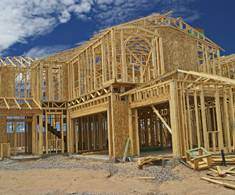As single-family home construction continues to rise with an almost 18 percent increase last year, the trend in homebuilding appears to be bigger homes – two-story more often than not – with more bedrooms, more bathrooms and larger garages.

Of the 569,000-plus single-family homes built in the United States last year, nearly 54 percent were two-story. One-third of them had three bathrooms or more, and 44 percent had four bedrooms or more, according to the Annual 2013 Characteristics of New Housing report by the U.S. Census Bureau, based on building permits from 900 markets around the nation.
The median square footage of homes built in 2013 was 2,384 square feet, the largest ever. That square footage number compares to a national median 1,525 sq. ft. in 1973; 1,905 in 1990; 2,227 in 2005; and 2,135 in 2009.
The trend toward larger homes is due, in part, to multigenerational home purchases as older children move back home and Generation X and younger Baby Boomers take care of their parents. A recent study by the National Association of Realtors showed that 22 percent of younger Baby Boomers, age 50 to 59, purchased multigenerational homes.
The homebuilding trends are interesting – some aspects have changed dramatically, while a few have stayed pretty much the same.
- Exterior Material Brick was the exterior of choice 40 years ago, with 35 percent of homes built with brick. Wood accounted for 20 percent of exterior construction and stucco 12 percent. Today, vinyl siding not available in the ’70s is the exterior most often used (31 percent of homes), followed by brick, 25 percent; stucco, 22 percent; fiber cement (introduced in the 2000s), 16 percent; and wood, only 5 percent.
- Bathrooms Very few homes anymore are built with only 1 1/2 baths or less – 5 percent. In 1973, 40 percent of home had fewer than two baths. By 1990, that figure was 13 percent. Today, one-third of new homes have three baths or more.
- More Bedrooms Three-bedroom homes have always predominated, but today larger homes of four bedrooms or more make up 44 percent of new home building.
- Two-Bedrooms A lower percentage of two-bedroom homes (10 percent) were built in 2013 than in decades. In 1973, 12 percent of newly built homes had two bedrooms compared to a high of 25 percent in 1985. In 2012, 13 percent of new homes were two-bedroom.
- Garages When it comes to garages, the trend is definitely larger. One in four new homes built in 2013 – the most ever at 21 percent – had a garage for three cars or more, while two-thirds had a standard two-car garage. Only 6 percent were built with a one-car garage, 1 percent with a carport and 8 percent with no covered parking. In 1973, only 40 percent of new homes had more than a one-car garage. By 1990, 78 percent did.
- Air Conditioning In 1973, 51 percent of homes were built with no air conditioning. By 1990, that number was cut in half to 24 percent. Today, only 9 percent of homes are built without air.
- Heating System Gas is the heating system found in most new homes today, with 61 percent powered by gas instead of electricity. Ironically, that’s the same percentage as in 1970. The use of gas fell substantially in the 1970s and ’80s before beginning to increase again. Then gas use fell again in the 2000s before becoming more popular again recently.
- Fireplaces The construction of fireplaces in new homes has returned to the levels of the 1970s with 45 percent of homes built in 2013 containing one fireplace. In the 1990s, nearly 60 percent of homes were built with fireplaces. The number of homes built with more than one fireplace has remained somewhat consistent through the years at about 6 percent.
Overall, the number of single-family homes built annually in the United States has increased by more than 27 percent since the lowest level in decades was recorded in 2011 when approximately 447,000 new homes were built. The highest number of homes constructed in a year took place in 2006, when 1.65 million new homes were built.
Of the 429,000 newly built homes sold in 2013, the average sales price was $324,000 compared to $292,000 in 2012.



